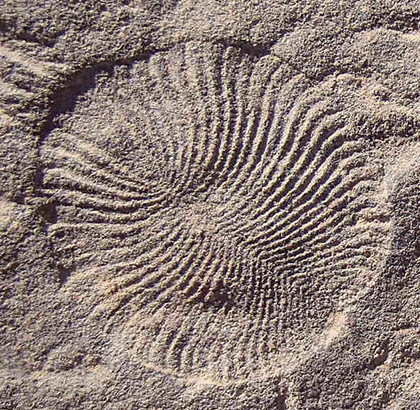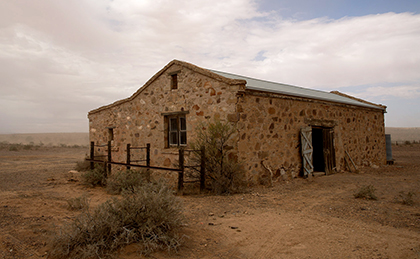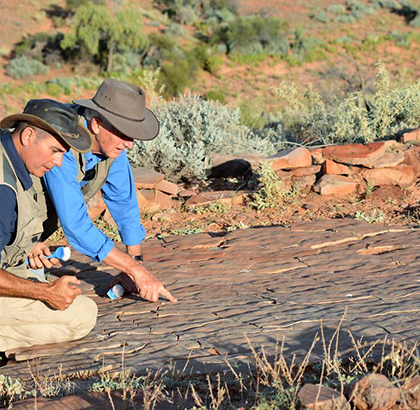A new foundation to preserve our Ediacaran fossils.
550 million years ago the Flinders Ranges area was a shallow tropical sea inhabited by earth’s first animals – large, complex marine organisms that are now referred to globally as the Ediacara biota in honour of the significance of the rocks and fossils of this area of this age. They were discovered in 1946 by renowned geologist Reg Sprigg who named them after the Ediacaran Hills.
The Ediacaran fossils in the Flinders Ranges area, and Nilpena Station specifically, record the advent of complex life uniquely and better than other similar sites around the world. Research at Nilpena records the first appearance of tens of new genera and biological firsts such as the oldest evidence for sexual reproduction and the start of mobility and scavenging.

Dickinsonia, a flexible, segmented mat-shaped animal from the fossil-rich Alice’s Restaurant Bed. (Courtesy of Flinders Ranges Ediacara Foundation)
The development of multicellular life is one of the most significant biological steps in the history of life. As such, it is of great interest to NASA’s mission to understand the physical, biological and chemical processes that led to the advent of complex life. Indeed much of the Nilpena research to date has been supported by NASA.
The Flinders Ranges Ediacara Foundation works to initiate the protection, management, ongoing research, public education and tourist opportunities of the Ediacaran fossils in the Flinders Ranges.
The foundation’s first goal – to help the Government of South Australia purchase the fossil beds and 60,000 hectares of Nilpena to expand the Ediacara Conservation Park – was achieved in March 2019, Historic agreements to protect Ediacara fossils. The foundation and the government also signed a memorandum of understanding for an ongoing partnership at Nilpena.

Restoration of the Blacksmith's Shop will create a new, immersive educational experience for visitors. (Courtesy of James Fitzroy Photography)
The foundation’s next goal is to work with the government to restore the historic Blacksmith’s Shop at Nilpena and create a new iconic visitor destination as part of a multi-year program to enhance the research, visitor and education potential of the site.
Thousands of visitors have been captivated by Nilpena’s treasures but not everyone can see them on the ground as it is difficult terrain and often unfavourable weather. To overcome this, a special fossil bed rich in different genera (Alice’s Restaurant Bed) will be moved into the Blacksmith’s Shop.

The South Australian Museum’s Dr Jim Gehling and Dr Diego García-Bellido at the Nilpena fossil site. (Courtesy of Flinders Ranges Ediacara Foundation)
The development of the Blacksmith’s Shop will be delivered and funded in part by the South Australian National Parks and Wildlife Service, with additional funding from the Australian Government’s Heritage Grants Program. The foundation’s 2019–20 fundraising campaign aims to secure further funding from corporate partners and individuals to enable delivery of this innovative interpretive facility and initiate the first step in a sustainable legacy for future generations.
The foundation has an ambitious strategic program to ensure these fossils are well managed in perpetuity for future generations, sharing their significance with the world, and providing sustainable equitable access to this evidentiary story of the earliest life on earth.
As Dr Andrew Thomas AO, retired NASA astronaut and first Australian in space has stated, ‘South Australia is custodian of fossil evidence of some of the most stunning ancient life forms on the planet. So important is this record that the geologic epoch when they originated is named after the Ediacara formations in the Flinders Ranges. The foundation is to be applauded in their efforts to raise awareness of this legacy and preserve these important sites’.
More on the Flinders Ranges Ediacara Foundation
Download the prospectus (PDF 3.4 MB)
Download the fundraising campaign brochure (PDF 2 MB)
– Mary Lou Simpson (Chair, Flinders Ranges Ediacara Foundation), October 2019


